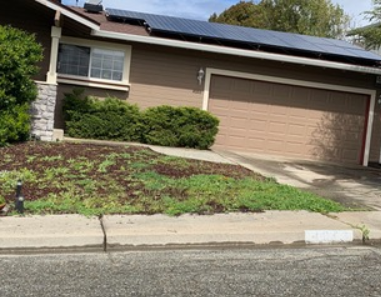Advice for the Home Gardener from the Help Desk of the
UC Master Gardener Program of Contra Costa County
Dear Help Desk: I'm writing to try to figure out the best approach to “fixing” our front yard: 4 years ago we pulled up the lawn and laid down weed block and put redwood chips on top. The weeds still spring up, and this year has been particularly bad. The wood chip “lawn” has essentially been overtaken by weeds. We'd like to retain the wood chip “lawn” in this part of the yard. Do you have suggestions for a fix? Should we just pull up the weeds and add 6” more wood chips as has been suggested by a friend?

1) Removing all the weeds currently growing. This ideally would be done by hand weeding, but you may also consider the use of herbicides. Which herbicide would work best is going to depend on the specific weed. If you need help identifying specific weeds, you can use the link below and we can provide help as well.
2) You may then want to water the area, wait for the weeds to germinate and then remove them while they are small. Doing this repeatedly a few times will greatly reduce your weed population long term.
3) Once you have adequately prepared your site, you will want to install a weed barrier. Ideally you want to use something organic that will decay such as cardboard or burlap. However, you may also try landscape cloth again.
4) After applying your weed barrier you will want to cover the barrier with 1-5 inches of mulch. The amount of mulch needed depends on which barrier you select. Landscape fabric requires less mulch than organic barriers.
5) This will not prevent all weeds and will need ongoing management. You will want to continue to remove weeds as early as possible, ideally by hand weeding. As your mulch breaks down, it also creates an organic layer that is very amenable to weed growth. The mulch layer does need to be periodically refreshed.
The following references may be helpful as you revitalize your front yard. It is certainly understandable that you want just mulch and no plants in your front yard, but it may be worth considering that putting desired plants into your yard will also help decrease weeds by competing for resources (sun, water, nutrients). Once you have eliminated these weeds, you may want to consider putting in some succulents or low-water native plants which may reduce the maintenance you need to do long-term.
http://ipm.ucanr.edu/PMG/PESTNOTES/pn7441.html
http://sacmg.ucanr.edu/files/163135.pdf
http://ipm.ucanr.edu/PMG/weeds_intro.html
Best of luck with your lawn and let us know if we can help further.
Help Desk of the UC Master Gardener Program of Contra Costa County (SES)
| Don't miss our 2019 Great Tomato Plant Sale - Antioch 4/13. Click here for more information>>: http://ccmg.ucanr.edu/tomato/ |
Note: UC Master Gardeners Program of Contra Costa's Help Desk is available almost year-round to answer your gardening questions. Except for a few holidays (e.g., last 2 weeks December), we're open every week, Monday through Thursday for walk-ins from 9:00 am to Noon at 2380 Bisso Lane, Concord, CA 94520. We can also be reached via telephone: (925) 608-6683, email: ccmg@ucanr.edu, or on the web at http://ccmg.ucanr.edu/Ask_Us/. MGCC Blogs can be found at http://ccmg.ucanr.edu/HortCoCo/ You can also subscribe to the Blog.